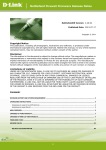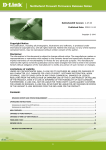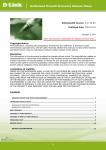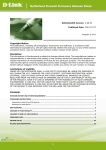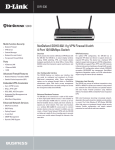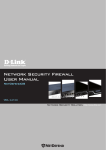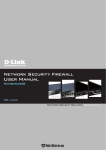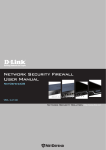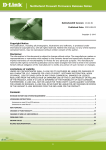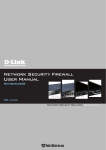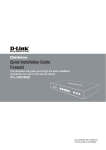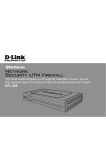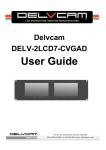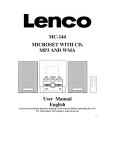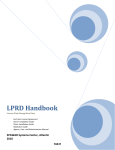Download DES-3028/52 Series Firmware Release Notes - D-Link
Transcript
NetDefend Firewall Firmware Release Notes
NetDefendOS Version: 2.27.08
Published Date: 2014-02-11
Copyright © 2014
Copyright Notice
This publication, including all photographs, illustrations and software, is protected under
international copyright laws, with all rights reserved. Neither this manual, nor any of the material
contained herein, may be reproduced without written consent of the author.
Disclaimer
The information in this document is subject to change without notice. The manufacturer makes no
representations or warranties with respect to the contents hereof and specifically disclaim any
implied warranties of merchantability or fitness for any particular purpose. The manufacturer
reserves the right to revise this publication and to make changes from time to time in the content
hereof without obligation of the manufacturer to notify any person of such revision or changes.
Limitations of Liability
UNDER NO CIRCUMSTANCES SHALL D-LINK OR ITS SUPPLIERS BE LIABLE FOR DAMAGES OF
ANY CHARACTER (E.G. DAMAGES FOR LOSS OF PROFIT, SOFTWARE RESTORATION, WORK
STOPPAGE, LOSS OF SAVED DATA OR ANY OTHER COMMERCIAL DAMAGES OR LOSSES)
RESULTING FROM THE APPLICATION OR IMPROPER USE OF THE D-LINK PRODUCT OR FAILURE
OF THE PRODUCT, EVEN IF D-LINK IS INFORMED OF THE POSSIBILITY OF SUCH DAMAGES.
FURTHERMORE, D-LINK WILL NOT BE LIABLE FOR THIRD-PARTY CLAIMS AGAINST CUSTOMER
FOR LOSSES OR DAMAGES. D-LINK WILL IN NO EVENT BE LIABLE FOR ANY DAMAGES IN EXCESS
OF THE AMOUNT D-LINK RECEIVED FROM THE END-USER FOR THE PRODUCT.
Content:
REVISION HISTORY AND SYSTEM REQUIREMENT: ................................................................................................... 2
UPGRADING INSTRUCTIONS: ...................................................................................................................................... 3
UPGRADING BY USING CLI VIA SCP PROTOCOL .......................................................................................................................... 3
UPGRADING BY USING WEB-UI .............................................................................................................................................. 3
NEW FEATURES: .......................................................................................................................................................... 3
CHANGES OF FUNCTIONALITY: .................................................................................................................................... 6
CHANGES OF MIB & D-VIEW MODULE: ....................................................................................................................... 6
PROBLEMS FIXED: ....................................................................................................................................................... 6
KNOWN ISSUES: ........................................................................................................................................................31
RELATED DOCUMENTATION: ..................................................................................................................................39
1
NetDefend Firewall Firmware Release Notes
Revision History and System Requirement:
Firmware
Version
2.27.08
Date
Model
Hardware Version
Feb. 11
2014
DFL-210/800/1600/2500
DFL-260/860
Apr. 03
2013
DFL-210/800/1600/2500
DFL-260/860
2.27.06
Oct. 30
2012
DFL-210/800/1600/2500
DFL-260/860
2.27.05
Dec 26
2011
DFL-210/800/1600/2500
DFL-260/860
2.27.03
Nov 24
2010
DFL-210/800/1600/2500
DFL-260/860/1660/2560/2560G
DFL-260E/860E
2.27.02
Sep 13
2010
DFL-210/800/1600/2500
DFL-260/860/1660/2560/2560G
2.27.01
July 5
2010
DFL-210/800/1600/2500
DFL-260/860/1660/2560/2560G
2.27.00
May 14
2010
DFL-210/800/1600/2500
DFL-260/860/1660/2560/2560G
2.26.02
Mar 4
2010
2.26.01
Jan 29
2010
2.27.07
2.26.00
2.25.01.28
2.25.01.22
2.20.03
2.20.02
Sep 15,
2009
July 15,
2009
Jun 11,
2009
Oct 21,
2008
Jul 10,
2008
DFL-160
DFL-210/800/1600/2500
DFL-260/860/1660/2560/2560G
DFL-160
DFL-210/800/1600/2500
DFL-260/860/1660/2560/2560G
DFL-210/800/1600/2500
DFL-260/860/1660/2560/2560G
DFL-210/260/800/860/1600/2500
DFL-210/260/800/860/1600/2500
DFL-210/260/800/860/1600/2500
DFL-210/260/800/860/1600/2500
2
A1 (for all models), A2 (for
DFL-210/800/1600/2500), A3 (for
DFL-210/800/1600), A4/A5 (for
DFL-210), B1 (for DFL-260/860)
A1 (for all models), A2 (for
DFL-210/800/1600/2500), A3 (for
DFL-210/800/1600), A4/A5 (for
DFL-210), B1 (for DFL-260/860)
A1 (for all models), A2 (for
DFL-210/800/1600/2500), A3 (for
DFL-210/800/1600), A4/A5 (for
DFL-210), B1 (for DFL-260/860)
A1 (for all models), A2 (for
DFL-210/800/1600/2500), A3 (for
DFL-210/800/1600), A4/A5 (for
DFL-210), B1 (for DFL-260/860)
A1 (for all models), A2 (for
DFL-210/800/1600/2500), A3 (for
DFL-210/800/1600), A4/A5 (for
DFL-210), B1 (for DFL-260/860)
A1 (for all models), A2 (for
DFL-210/800/1600/2500), A3 (for
DFL-210/800/1600), A4/A5 (for
DFL-210), B1 (for DFL-260/860)
A1 (for all models), A2 (for
DFL-210/800/1600/2500), A3 (for
DFL-210/800/1600), A4/A5 (for
DFL-210), B1 (for DFL-260/860)
A1 (for all models), A2 (for
DFL-210/800/1600/2500), A3 (for
DFL-210/800/1600), A4/A5 (for
DFL-210), B1 (for DFL-260/860)
A1/A2 (for all models), A3/A4/A5
(for DFL-210/800/1600/2500),B1
(for DFL-260/860)
A1/A2 (for all models), A3/A4/A5
(for DFL-210/800/1600/2500),B1
(for DFL-260/860)
A1 (for all models), A2/A3/A4/A5
(for DFL-210/800/1600/2500)
A1 (for all models), A2/A3/A4 (for
D F L- 2 1 0 / 8 0 0 / 1 6 0 0 / 2 5 0 0 )
A1 (for all models), A2/A3/A4 (for
D F L- 2 1 0 / 8 0 0 / 1 6 0 0 / 2 5 0 0 )
A1 (for all models), A2/A3/A4 (for
D F L- 2 1 0 / 8 0 0 / 1 6 0 0 / 2 5 0 0 )
A1 (for all models), A2/A3/A4 (for
D F L- 2 1 0 / 8 0 0 / 1 6 0 0 / 2 5 0 0 )
NetDefend Firewall Firmware Release Notes
Upgrading Instructions:
Upgrading by using CLI via SCP protocol
SCP (Secure Copy) is a widely used communication protocol for file transfer. No specific SCP client
is provided with NetDefendOS distributions but there exists a wide selection of SCP clients
available for nearly all workstation platforms. SCP is a complement to CLI usage and provides a
secure means of file transfer between the administrator's workstation and the NetDefend Firewall.
Various files used by NetDefendOS can be both uploaded and downloaded with SCP. This feature
is fully described in Section 2.1.6, “Secure Copy” of NetDefend Firewall v2.27.05 user Manual.
Upgrading by using Web-UI
For detailed installation and upgrade instructions, please refer to the Firmware Upgrades chapter
in the NetDefend Firewall v2.27.05 User Manual.
New Features:
Firmware
Version
New Features
2.27.08
No new features were introduced in the 2.27.07 release of NetDefendOS.
2.27.07
No new features were introduced in the 2.27.07 release of NetDefendOS.
2.27.06
No new features were introduced in the 2.27.06 release of NetDefendOS.
1. The WebUI page "Reset" now also contains a method for normal shutdown
(same action as the CLI command "shutdown"). This method will gracefully
2.27.05
close down tunnels, hand over to other HA unit (in HA scenarios) and so on.
2. The cache size for the Web Content Filtering (WCF) feature has been
increased. The size is now doubled on all hardware models.
3. The drop down menu for services has been enhanced to show port numbers.
1. The File Integrity tab for ALGs has been re-arranged with a more logical view
for MIME type check.
2.27.03
2. Added possibility to sort data grids. Sorting on anything except column index
will hide grouping.
3. New setting for High Availability failover timeout value that specify the
timeout before HA failover is triggered.
1. The D-Link DES-3528 switch can now be used by ZoneDefense.
2. A new log message has been added indicating that an ARP resolve query
2.27.02
failed.
3. The following browsers are now supported: Firefox 3+, Opera 10.5+, Safari
3+, Internet Explorer 7+ and Chrome 4+.
3
NetDefend Firewall Firmware Release Notes
2.27.01
1. A confirmation question will be prompted if the user attempts to execute a
CLI command that may cause system delays.
1. Grouping configuration objects into logical groups makes it easier to
manage large number of configuration objects. It is also possible to add a
descriptive description and custom color to distinguish what these objects
do. This grouping functionality is only for presentation and does not affect
the existing functionality.
2. Logging enabled by default on rules for the following objects: Access, DHCP
Server, DHCP Relay, Routing Rule, Dynamic Routing Policy Rule, IDP Rule
Action, IP Rule, OSPF Router Process, Threshold Action and User
Authentication Rule.
3. Static configuration objects default to their default values if the objects
contain configuration errors. This will prevent the firewall to misbehave due
2.27.00
to configuration errors on static objects.
4. The script command has been updated to handle adding objects with
dependencies between each other.
5. User authentication has been updated with a new authentication source that
will grant access to the user without checking any credentials. This
functionality can be used to authenticate users from within login scripts etc,
to make auditing easier.
6. All rule page layouts have been updated for how to enter the interface and
network combination to be more intuitive.
7. The data grid in the Web User Interface now displays information for simple
objects as tooltip (an example is a reference to an IP4Address which would
show the address value as a tooltip).
[DFL-210/260/800/860/1600/1660/2500/2560/2560G]
1. Added the possibility to disable and enable Ethernet interfaces using
WebUser Interface.
2.26.02
2. Separate icon for User Authentication enabled objects.
3. Improved file names for backup packages, including the configuration
version number.
4. Connection Rate Statistic Values can be viewed using SNMP.
[DFL-210/260/800/860/1600/1660/2500/2560/2560G]
1. The name of the authenticated user is logged together with the requested
2.26.01
URL in HTTP ALG log messages
[DFL-160]
4
NetDefend Firewall Firmware Release Notes
1. DHCP relaying through the firewall in transparent mode is supported
2. DH Group and PFS can be configured on IPsec interfaces
2.26.00
1. The name of the authenticated user is logged together with the requested
URL in HTTP ALG log messages
2. DFL-210 and DFL-800 support anti-virus and dynamic web content filtering
No new features in this version.
2.25.01.28
This firmware version is positioned to replace v2.25.01.22 because the
v2.25.01 will cause device into cycle reboot when IPSec encapsulation was set
as “Both”.
1. Added version check for external language files
2. Improved logging for Anti-SPAM
3. New log message at failover triggered by linkmon
4. A new advanced setting has been added to control the number of
RADIUScommunication contexts that can be used simultaneously
5. DNS name resolving uses the shared IP in High Availability setups
6. Added support for Host Monitor for Routing
7. Added command to handle language files on disk
8. Improved LDAP functionality
9. Redesign of the tuple value controller in the webUI
10. Display of network objects
11. Extended route monitoring capabilities
12. The IPsec status page has been improved
13. PCAP Recording
2.25.01.22
14. New advisory link in virus found log messages
15. The webUI has been extended to handle child objects in a tab
16. Support of custom monitor interval in Linkmonitor
17. ZoneDefense now supports DGS-3200 series switches
18. Anti-Virus triggered ZoneDefense
19. LDAP Authentication
20. Route Load Balancing
21. Extended SIP Application Layer Gateway supporting new scenarios
22. TCP transport added to the SIP Application Layer Gateway
23. Multiple media connections for SIP Application Layer Gateway
24. PPTP server support for multiple PPTP clients behind the same NAT gateway
25. PPTP server and client have been extended to support stateful MPPE
26. Improved verification of IP4 values
27. IDP Triggered Traffic Shaping
28. AVSE_MaxMemory setting has been removed
5
NetDefend Firewall Firmware Release Notes
29. Relayer IP address filter at DHCP Server
30. Support for VLAN priority derived from IP DSCP precedence
31. Gigabit Traffic Shaping Support
32. The PPPoE client has been changed to support unnumbered PPPoE
33. Improved server monitoring for Server Load Balancing
34. The ping CLI command has been improved
35. The schedule page has been improved
36. SSL/TLS Termination
2.20.03
2.20.02
1. No new features were introduced in the 2.20.03 release.
1. MTU can be configured for PPPoE Interfaces
2. MTU can be configured for PPTP/L2TP Client Interfaces.
Changes of Functionality:
Firmware
Version
Modified Features
2.26.00
1. DFL-210 and DFL-800, remove IDP Maintenance Service
Changes of MIB & D-View Module:
Support memory usage and TCP buffer usage monitoring.
Problems Fixed:
Firmware
Version
2.27.08
Problems Fixed
1. Using SCP to download a file from the firewall whose filename included a
hyphen would fail with a "Permission denied" error message.
2. In some situations the system would send an extra TCP ACK packet when it
did not need to.
3. When using a service group which contained overlapping services, there was
no warning message that this may cause undefined behavior.
4. When "arp -notify" was used in an HA setup, the firewall incorrectly used its
private MAC address instead of the shared MAC address.
5. Changes made to the HTTP normalization parameters on an IDP rule were
ignored unless other settings were changed on the same IDP rule.
6
NetDefend Firewall Firmware Release Notes
6. A static DHCP lease was not treated as static anymore if the IP had been
blacklisted and then being released from the blacklist. The static leases are now always kept
static and related temporarily assigned leases during blacklist are cleaned from the lease pool.
7.
The Log and Event receivers did not support using another routing table than
"main".
8.
Hardware statistics for some Realtek interfaces was incorrectly represented
in the CLI and could not be reset.
9.
The HostMonitor subsystem could cause an unexpected restart during
reconfiguration when used together with Server Load Balancing.
10. When using a NAT Pool with a large amount of addresses, the performance
was affected in a negative way.
11. The CLI tab completion when adding a Custom Option for a DHCP Server was
confusing and has been improved.
12. On rare occasions the system could make an unexpected restart when using
the HTTP ALG together with Anti-Virus scanning.
13. In rare cases when a heavy load of IPsec traffic was sent through the firewall
there could be logs about hardware acceleration failure with performance
degradation as a result. Affects:
DFL-210/DFL-260/DFL-260E/DFL-800/DFL-860/DFL-860E.
14. The internal SSH Server could in rare circumstances use an increasing
amount of memory.
15. The firewall would always perform automatic updates of IDP and AV
databases on startup and HA activation. Automatic updates will now only
occur at the configured time.
16. Configuration pages with a very large amount of objects could have the last
object hidden by Internet Explorer.
17. Certain configurations related to one sub system could cause a security
vulnerability.
18. POP3 ALG log messages would sometimes contain incorrect e-mail
addresses.
19. On rare occasions, the SMTP and POP3 ALGs could not read fields from
theDataHeader correctly.
20. The DHCP Client did not renew its IP address lease after a link failure had
been restored.
21. TCP traffic inside an IPsec tunnel using Transport Mode where both peers
were located behind a NAT gateway did not work as expected, SYN-ACKs
never reached client, when the firewall was configured with SynRelay.
22. The community string in SNMP Remote Management was truncated if it was
7
NetDefend Firewall Firmware Release Notes
longer than 32 characters.
23. Unsolicited ARP reply was not handled correctly according to the
UnsolicitedARPReplies setting. The setting for Multiple Username Logins on
the User Authentication Rule did not work as intended when selecting to use
timeouts from the authentication server.
24. Certain SIP PBX configurations caused the firewall to drop INVITE requests.
25. It was possible to configure multiple static DHCP hosts with the same IP or
MAC address without getting a configuration warning.
26. The system would set the BROADCAST flag in DHCP Discover and DHCP Request
messages, despite being fully capable of receiving unicast replies.
27. The updatecenter CLI command would return an error if no argument was
specified. It will now show the status of all databases as default action.
28. The L2TP/PPTP client used the wrong source IP when the interface used for
L2TP/PPTP traffic was changed due to a DHCP update.
29. NATed traffic sometimes used an old source IP address for connections
opened prior to a dynamic update of the IP address of the outgoing interface.
30. The switch driver used on DFL-260E (rev a2) appliances had a faulty default
configuration, which lead to performance issues.
2.27.07
1. In some rare occasions, the memory consumption of the firewall could
increase unexpectedly when deploying cluster configurations.
2. The output list from the CLI command 'vlan' was not sorted in VLAN ID order.
This has been corrected and the command was enhanced with the
parameters to segment long output lists ‘num’ and ‘page’.
3. The 'blacklist' CLI command did not set the correct port number and
destination URL in its output.
4. A configuration with the now obsolete selection of Log And Event Receiver
category '36 (USAGE)' would send out empty log data. The configuration is
now silently updated to exclude this category.
5. The shared IP was not used in LDAP server queries for High Availability
cluster nodes.
6. The realm string for HTTP basic authentication was incorrectly not optional in
the configuration.
7. The unit for the OSPF memory max usage in the WebUI was 'kilobytes', but
has now been corrected to 'bytes'.
8. The Local Gateway configured in an IPsec tunnel was not shown in the CLI
command "ipsectunnels -iface" printout.
9. The link status of the DMZ, WAN1 and WAN2 interfaces on the DFL-860E
model and DMZ and WAN on the DFL-260E would disappear shortly during
8
NetDefend Firewall Firmware Release Notes
the reconfigure process.
10. The filename for an attachment was incorrectly required for the SMTP ALG
and POP3ALG. The ALGs have now been updated to handle attachments
without filenames, according to the RFCs.
11. The SIP ALG did not use the "420 Bad Extension" response in certain
circumstances.
12. The built in L2TP client did not work correctly when put behind a NAT device.
13. The configuration was not always updated correctly when upgrading to a
newer version.
14. HTTPS webauth using Internet Explorer versions 8 and older did not show the
logged in page after the user had logged in.
15. When using a large number of neighbors in nodes running OSPF, there was a
rare possibility of memory corruption.
16. A prompt was not added after various SSH printouts in the CLI.
17. Routemon did not detect link state changes on some Realtek interfaces.
Affected models: DFL-260E/DFL-860Es.
18. The link status info for the Realtek interfaces disappeared after a reconfigure.
Affected models: DFL-260E/DFL-860E
19. In some scenarios with IDP configured, traffic of certain patterns could in rare
circumstances be delayed
20. It was not possible to connect multiple L2TP/IPsec clients behind the same
NAT gateway.
21. SNMP Interface Alias field was empty when selecting "Comment" in
"Interface Alias".
22. If L2TP clients with the same local IP address established IPsec tunnels
behind a NAT device there were sometimes problems with the connections.
23. The OSPF routes database was not updated during reconfigure in some High
Availability scenarios.
24. In some unusual circumstances the use of XAuth based authentication would
lead to an unexpected reboot
25. The web user interface was not 100% compatible with Explorer 10. The basic
structure has now been updated to render the page correctly in all major
browsers.
26. The firewall Dynamic Routing Rules did not properly export / import OSPF
routes when they were filtered by "OSPF Tag range" or "Router Type".
27. A few log message categories, such as SSL VPN and IPv6 Neighbor Discovery
were missing from the log message exception list..
28. In some scenarios when using IPsec with XAuth, ESP delete notifications
would not be sent.
9
NetDefend Firewall Firmware Release Notes
1.
Corrected leap year problem where leap year day was added to January
instead of February.
2.
The log event no_arp (ID:04100007) firewall action text was previously
route_enabled, the text is now corrected to route_disabled.
3.
Time unit 'seconds' added to help texts in WebUI ALG SIP dialog and CLI
command 'help ALG_SIP'.
4.
The memory consumption of the firewall could in some rare occasions
increase unexpectedly when deploying cluster configurations.
5.
The output list from the CLI command 'vlan' was not sorted in VLAN ID
order. This has been corrected and the command was enhanced with the
parameters to segment long output lists using 'num' and 'page'.
6.
The 'blacklist' CLI command did not set the correct port number and
destination URL in its output.
7.
The output text for the CLI command 'dns -list' was not formatted correctly
when using SSH remote management.
8.
In rare occasions, closing down a SIP session could lead to an unexpected
restart.
9.
2.27.06
Using the H323 ALG could in rare circumstances lead to malfunction.
10. The corruption of a linked list could lead to a crash. This is corrected now.
11. The output of the CLI command "ifstat" has been extended to list the shared
MAC addresses on the interfaces of High Availability cluster nodes.
12. During tunnel set up, the L2TP client would abort and restart tunnel
negotiation if the server response deviated from commonly agreed
communication protocols.
13. In a rare High Availability situation where a large amount of IPsec traffic
(with a very large number of tunnels) was making the firewall loaded, it was
possible that both nodes were set as the active node.
14. A prompt was not printed in the CLI after activating a new configuration.
15. In scenarios where all routes announced in an OSPF area are added to a
routing table, pre-existing static routes could be overwritten. Now static
routes received from the OSPF process will not replace pre-existing static
routes in a routing table.
16. The filename for an attachment was incorrectly required for the SMTP ALG
and POP3 ALG. The ALGs have now been updated to handle attachments
without filenames, according to the RFCs.
17. Static destination address translation would fail for transport mode IPsec
traffic.
18. When using a large number of neighbors in nodes running OSPF, there was
10
NetDefend Firewall Firmware Release Notes
a rare possibility of memory corruption.
19. An expired AV or IDP license in an HA environment could trigger unexpected
behavior in the inactive cluster node.
20. Some web authentication scenarios could lead to unexpected behavior by the
firewall.
21. Some VPN configurations using Radius Accounting did not report in/out octet
statistics to the Radius Accounting server.
22. The H.323 ALG did not allow FACILITY messages to be sent during the
ALERTING state.
23. In some cases, the ping -verbose CLI command did not print the correct
translated port if the packet was affected by a SAT rule. The correct
translated port will now be printed.
24. In certain scenarios, traffic originating from LDAP could lead to unexpected
behavior by the firewall.
25. CorePlus did not handle lower and upper case correctly in some configuration
scenarios where objects were named almost identically.
26. In some High Availability scenarios, the HA setting ReconfFailoverTime was
not obeyed, resulting in a failover when deploying a configuration on the
2.27.05
active peer before the ReconfFailoverTime was reached.
27. Setting up a High Availability cluster using the "backup and restore" method
would result in problems synchronizing the configuration because of an
invalid interface configuration. The units now correctly handle that interface
configuration by using information from the old configuration.
28. A recent change in scp (secure copy) use an end of option parameter that
was handled erroneously by the firewall. Now this option is handled correctly
and scp connections will no longer be closed unexpectedly.
29. The Web Content Filtering (WCF) server connection could stall after a
reconfigure and fail to resolve new URLs. The issue has been corrected
together with additional server connection statistics for the 'httpalg
-wcfcache' CLI command.
30. Some network scenarios caused the SIP ALG to close SIP calls two minutes
after the call was established.
31. Using a PPTP server together with pipes could occasionally prevent the PPTP
server from accepting new connections.
32. Passive OSPF-interfaces were allowed to send out "OSPF-hello" messages.
Passive OSPF-interfaces are now prohibited from taking part in the OSPF
discovery process.
11
NetDefend Firewall Firmware Release Notes
33. OSPF did not detect the link status of physical interfaces. Link status is now
periodically monitored within OSPF.
34. The HWM functionality was malfunctioning for the DFL-1600 and has been
corrected in this release.
35. The "Route Type" in "OSPF Actions" was incorrectly interpreted by the
firewall when the configuration was activated.
36. The source port 20 is now used when combining the SAT Action in an IPRule
with the FTP ALG.
37. An unexpected restart could occur during a configuration deployment when
new IPsec tunnels were added to the configuration. Changes have been
made to prevent a resource conflict, causing the unexpected restart.
38. It was not possible to use all address object combinations in places like
routes or in the Address Book. The WebUI validation code has been extended
to handle arrays of IP4 Addresses in order to correct the problem.
39. TLS ALG rejected SSL HELLOs with zero or more than 1 compression method.
40. Invalid values entered in properties in the WebUI would silently be rejected.
An error is now properly reported when a property has an error.
41. Some cipher suite combinations prevented the AES256 algorithm to be used
when establishing SSH administration sessions to the firewall.
42. Some specially crafted SDP payloads could cause unexpected reboots of the
firewall.
43. The WebUI page for interface status showed the Send Rate and Receive Rate
as average for the last 24h. The values have been updated to use the average
for the last 2 minutes.
1. The usage column in the DHCP Server status page has been updated to show
active clients.
2. References to UserAuth privileges for authenticated users could change when
modifying the number of configured privileges.
3. The web server could under certain conditions deadlock and print a "500 Internal Server Error" message when trying to access the web user interface.
2.27.03
The web server has been extended with better error handling to prevent this kind
of deadlock.
4. The interface traffic counters were only of size 32-bit and often wrapped
around when the throughput was high. Corresponding 64-bit counters have been
added to ensure that wrapping will not occur as often as the corresponding 32-bit
values.
5. The block list file verification failed for files with a size smaller than one packet.
The blocklist now validates the extension for the first packet when the content
12
NetDefend Firewall Firmware Release Notes
type could not be determined in the first packet.
6. In certain scenarios, the voice transmitted through the SIP ALG terminated
suddenly two minutes after the call was established.
7. Office "xlsm" files were blocked by the SMTP ALG. Encrypted "xlsm" files are
embedded in an "Office 97/2000 Compatible" container which results in an
incorrect file typ according to file integrity control. The file integrity control has
been updated to handle encrypted "xlsm" files.
8. A faulty model check made the Switch Management not display all the switch
ports in the WebUI for the DFL-860E model.
9. The Realtek 8169 interface reported link down incorrectly. This caused route
monitor to not work properly. Affects: DFL-260E and DFL-860E.
10. The HTTP ALG failed to load web pages from certain web servers correctly.
The HTTP ALG will now respond with a TCP RESET should the server continue to
send packets after the client has closed the connection.
11. Anti-virus scanning of zip files containing files with a large compressed size
could sometimes lead to unexpected behavior.
12. Using HTTP web authentication with a RADIUS server as authentication
source, could in very rare scenarios cause the firewall to malfunction during save
& activate (reconfigure).
13. Two HTTP ALGs with the same name, but with different case (e.g.
"MYHTTPALG" and "myhttpalg"), could sometimes cause the firewall to freeze
during save & activate (reconfigure).
1. It was not possible to use User Authentication on IP4Group objects.
2. Certain SIP server scenarios in REGISTER transactions made the firewall
reject incoming SIP calls.
3. In some situations when using SMTP ALG with Anti-Virus e-mails with
attachments would not be completely transferred, resulting in a timeout. The
ALG Anti-Virus feature now specifically logs failure to decompress encrypted zip
files. A setting to allow or deny encrypted zip files have also been added.
2.27.02
4. The usage bars on the DHCP Server status page were not displayed correctly
when leases reached 100% usage.
5. ACK messages for non 2xx PBXs responses were not forwarded by the SIP
ALG.
6. The DHCP Server did not send DHCP NAK messages in all scenarios. This
change speeds up the process of receiving a new IP address lease in these
scenarios.
7. The SMTP ALG always allowed emails where the SMTP "from" address and
email header "from" address did not match. A new setting has been added which
13
NetDefend Firewall Firmware Release Notes
allows the administrator to deny or tag these mails as spam.
8. CLI command "ipsecdefines" has been removed from "techsupport"
command.
9. During configuration certain values were not reset after parsing an IGMP
Report rule, which made the next IGMP Query misbehave. The configuration
values are now properly reset after parsing IGMP Report rules.
10. Incoming SIP traffic routed through an IPsec tunnel was discarded by the SIP
ALG.
11. Some empty configuration values were not written to the configuration.
After a restart of the firewall the default values were used instead.
12. Some buttons in the web user interface had truncated text.
13. The reception of 255.255.255.254 as Framed-IP-Address in a RADIUS
negotiation wasn't handled correctly in all installations. Now this will always lead
to an IP being assigned, to the PPTP-/L2TP-client, from the configured IP pool.
14. It was not possible to click on the IDP signature group links in the web user
interface page "IDP Factory Signatures". Clicking on the link now lists the
signatures in the group.
15. The DNS client always dropped DNS replies that had the truncated bit set.
The truncated bit indicates that the reply does not contain the complete response
and that a new DNS request should be sent using TCP (if the client supports TCP
DNS). The DNS client now uses the addresses in the partial response instead of
ending up with no address at all.
1. Certain SIP PBX configurations blocked media transmission on calls
established between devices located on the same interface of the firewall.
2. The POP3 ALG did not reset its state after a failed authentication. This could
cause the next login attempt to fail.
3. Specific Intrusion Detection Protection (IDP) scenarios using hardware
acceleration could cause scans to fail.
4. Restarting a GRE interface did sometimes trigger an unexpected restart of the
2.27.01
firewall.
5. The POP3 ALG did not allow Digest-MD5 authentication.
6. The SIP ALG could forward malformed SIP messages if a range 0-65535 was
used as destination port in the SIP service configuration.
7. Specific scenarios using the PPTP ALG could sometimes cause an unexpected
restart of the firewall.
8. The log message sent when reclassifying a URL using Web Content Filtering
showed the wrong category. The log message has been updated to display the
correct category.
14
NetDefend Firewall Firmware Release Notes
9. Web User Interface: Activating a configuration that had deleted an item that
was represented in the navigation tree would not automatically update the
navigation tree. This resulted in a navigation tree that did not correspond to the
running configuration.
10. Checked checkbox properties that were disabled were unchecked when
submitting data in the Web User Interface (since information sent by a web
browser is identical for an unchecked checkbox and a disabled checkbox). The
configuration engine now correctly remembers the state of disabled checkboxes
when submitting data.
11. The HTTP ALG MIME type check did not have support for OpenDocument Text
Documents (odt).
12. Script execute did not allow the 'cc' command to run without parameters.
The command has been updated.
1. The IP4 Group object didn't handle excluded addresses correctly. It's now
possible to use excluded and included objects in the correct way.
2. Certain SIP option messages with high values for the "expires" header field
failed to be properly parsed. When that occurred incoming calls to phones
placed behind the firewall failed.
3. Some HTTP headers could cause HTTP connections through the HTTP ALG to
be closed down prematurely.
4. On DFL-260/ DFL-860, some specific high stressed Intrusion Detection and
Protection scenarios using a hardware accelerator could drain the memory of
the firewall.
5. The SMTP ALG did not accept response codes that only contained numeric
data.
2.27.00
6. Browsing the Web User Interface over HTTPS would sometimes result in
"Error 500 - Internal server error".
7. On DFL-1600/DFL-1660/DFL-2500/DFL-2560(G), after a reconfiguration
using a HA configuration the interface synchronization list for the Inactive
node contained invalid interface references which could cause problems
when connections were synchronized before the list was rebuilt. The
references are now properly cleared during a reconfiguration.
8. In the Web User Interface, when defining an IDP Rule, the check box to
enable or disable the option "Protect against insertion/evasion attacks" was
not visible.
9. The CLI techsupport command always sent a "sesmgr_file_error" log
message, even when it worked correctly. The techsupport command now
only sends log message when it fails.
15
NetDefend Firewall Firmware Release Notes
10. A limitation on the number of simultaneous WebAuth transaction could
prevent the authentication of authorized users.
11. The IP Rule view in the Web User Interface was slow when viewing large
collection of rules. The rendering speed has been improved.
12. Dropdown menus in the Web User Interface used a fixed width, which caused
objects with long names to push information outsize the window. The
dropdowns are now scaled to be able to show all the information. The
dropdown also automatically scrolls to the selected item when opened.
13. The Mappings and Leases links on the DHCP Server status page in the Web
User Interface didn't work.
14. Disabling objects with references in the Web User Interface would delete the
objects and references instead. The objects are now only disabled when
selecting to disable them.
[DFL-210/260/800/860/1600/1660/2500/2560/2560G]
1. The "range" parameter in the "rules" CLI command did not work.
2. The CLI command "dns -query" only returned one IP address even though the
DNS Record contained multiple entries.
3. An error in the configuration engine caused problems when configuring the
first OSPF Area for an OSPF Router Process.
4. When using services with the SYN flood protection (SYN Relay) functionality
enabled, reconfigurations could result in unexpected behavior.
5. Certain conditions sometimes led to an unexpected behavior when a firewall
had IPsec tunnels configured.
6. It was not possible to use User Authentication enabled objects in Routing
Rules, Threshold Rules, IDP Rules or Pipe Rules.
2.26.02
7. The log pages for the Web User Interface were rendered incorrectly resulting
in artifacts on some web browsers.
8. The SMTP ALG did not load all whitelist and blacklist entries if the number of
entries were more than about 30. The entries that failed to load were silently
ignored. All configured whitelisted and blacklisted addresses are now loaded and
filtered correctly.
9. Users were not properly logged in when IPsec LAN to LAN tunnels were
configured to require IKE XAuth. This could cause an unexpected reboot. Now
the LAN to LAN case is properly handled by IKE XAuth.
10. The L2TP/PPTP Server overview grid did not have a column for "Server IP".
11. The dropdown to select the interface for OSPF Neighbor in the Web User
Interface printed the name wrongly. The dropdown code has been enhanced to
handle this value correctly and print the proper name.
16
NetDefend Firewall Firmware Release Notes
12. The validation of the latency setting in the Host Monitor configuration was not
correct. The configured value was lowered to an incorrect value.
13. The setup wizard only created the second of the two possible Syslog servers.
The first Syslog server is now correctly created by the wizard.
14. The "min" and "preferred" input fields had swapped position on the
configuration page for IPsec Algorithms and IKE Algorithms in the Web User
Interface. The position of the input fields has been corrected.
15. In the Web User Interface it was not possible to change order of objects that
were both disabled and deleted. It's now possible to move objects that are both
disabled and deleted.
[DFL-160]
1. Enabling POP3 on the Inbound Traffic page did not have any effect.
[DFL-210/260/800/860/1600/1660/2500/2560/2560G]
1. A configuration that contains a routing table loop could lead to the watchdog
being triggered. Now the configuration will fail to be activated with the following
message: "Dynamic routing configuration error, possible configuration loop".
2. Setting both "IKE Lifetime" and "IPsec Lifetime" to 0 seconds in an IPsec
tunnel triggered a warning message on the console referring incorrectly to
another property.
3. Proposal lists were not properly listed in command line "ipsectunnel -iface"
output.
4. When using a user authentication rule for HTTPS with LDAP, an SSL socket
was sometimes not closed, possibly resulting in instability.
5. It was not possible to use certificates that had no alternative name set.
2.26.01
6. Due to memory corruption occurring in some setups, the internal timers
caused the firewall to restart unexpectedly. Depending on the traffic load, the
reboots occurred periodically from a few hours up to several days. This issue has
been corrected together with fixes in the loader.
7. The establishment of SYN flood protected TCP connection could be
unnecessarily delayed due to the firewall dropping all the packets sent by the
client side while waiting for the completion of the three-way handshaking
between the firewall and the server.
8. Updates of the Anti-Virus database could only be done when the Anti-Virus
functionality was enabled. The database can now be updated even though no
Anti-Virus functionality is enabled
9. The license page showed an incorrect value for maximum number of PPP
tunnels.
17
NetDefend Firewall Firmware Release Notes
10. Running certain sequences of CLI commands (or performing corresponding
actions in the Web User Interface) involving multiple "reject" commands, could
cause a critical malfunction in some cases.
11. After running the CLI command "reject" with a configuration object as
parameter, activation of configuration changes could fail with an error message,
but "show -errors" would say that there were no errors. The "show -errors"
command has been updated to correctly display these errors.
12. Keep-alive SIP pings were not handled correctly and would generate drop
logs. The SIP pings are now handled correctly and a response pong is sent.
13. The console command always printed that it showed the events for the last
30 days even though nothing had happened. The command has been updated so
it will print the date of the oldest entry. If entries exist that are older than 30 days
it will print 30 days and truncate, if less than 30 days, date of last entry will be
printed.
14. The system information slides on the front panel display could stop after
showing the first sensor under certain conditions when Hardware Monitor was
enabled. The system information slides can now loop through all pages without
getting stuck. Only affected hardware models with front panel display.
15. There was a critical defect in the Web Content Filter functionality that could
cause the firewall to reboot unexpectedly.
[DFL-160]
1. It did not work to have DHCP assigned IP on the WAN interface and at the
same time relay DHCP requests to hosts on the LAN or DMZ in transparent mode.
2. If the Internet connection had dynamic IP address (DHCP enabled) and
transparent mode was used on LAN or DMZ, the IP address on the LAN / DMZ
interface was set to 0.0.0.0.
1. PPP negotiations were sometimes slower than necessary.
2. Deploying a configuration during heavy traffic load could cause a watchdog
reboot.
3. It was possible to enable the anti-spam feature DNSBL on an SMTP-ALG
without specifying any DNSBL servers. Configuring DNSBL without specifying
2.26.00
any servers will now give an error.
4. Some errors in IPsec tunnel configuration were not correctly treated during
the firewall start up process, resulting in IPsec tunnels not properly being set up.
Now most of those errors make the tunnel be disabled and a warning message be
displayed. For the most severe ones the configuration will be rejected by the
system.
18
NetDefend Firewall Firmware Release Notes
5. Running FTP-ALG in hybrid mode could result in the first packet being dropped
when the connection to the server isn't established, and this leads to a three
seconds delay. The connection from the ALG to the client will now not be initiated
until the server connection is established towards the ALG.
6. It was not possible to move a rule up or down in the list if the rule was
disabled.
7. The command "ipsecstats" could in some circumstances not show all tunnels
when a tunnel name was given as an argument. The command now displays all
the tunnels when tunnel name is given as an argument.
8. The command "ipsecstats" only listed the first matching IPsec SA when a
tunnel name was given as an argument. The command now displays all IPsec
SAs that are connected to the specified tunnel name.
9. The FTP-ALG virus scanner triggered an unexpected restart if the virus
signature database was updated while files were being processed by an FTP-ALG
configured with fail-mode set to allow.
10. The "ippool - show" CLI command output showed all configured pools, which
could be a very long list. Now only the first ten are listed by default. The "-max
<num>" option can be used to display more items.
11. The SIP-ALG didn't handle "183 Session Message" when initiating a new SIP
call.
12. The return traffic for ICMP messages received on an IPsec transport mode
interface was wrongly routed to the core itself and then dropped. The return
traffic is now passed back using the same connection as it arrived on.
13. Tab completion in the command line interface (CLI) did not work on IPsec
tunnels when using the "ipsecstats" command. Tab completion is now possible to
use in the "ipsecstats" command.
14. The firewall did not accept certificates signed with RSA-SHA256.
15. Timezone setting could make the minimum date limit in scheduling to wrap
and become a date into the future. The minimum and maximum dates in
scheduling have been modified to be between the years 2000 and 2030 which
will not trigger the incorrect behavior.
16. The SMTP-ALG incorrectly blocked emails sent using the CHUNKING (BDAT)
extension. The ALG has been modified to remove the CHUNKING capability from
the server's EHLO response. This allows the emails to pass through the ALG.
17. It was not possible to connect to the firewall using SSH if lots of public keys
were registered in the SSH client.
18. The firewall could unexpectedly restart when disabling automatic updates of
anti-virus and IDP updates.
19
NetDefend Firewall Firmware Release Notes
19. IPsec tunnels with a DNS name as remote endpoint would cease to function
after a remote endpoint IP address change.
20. Blacklist could potentially write to media up to five times each minute. The
delay between possible writes has been increased to two hours.
21. It was not possible to configure "maximum authentication retries" for the
SSH server in the web user interface. Configuration support has now been
added.
22. There was a problem when multiple IPsec SAs referenced the same XAuth
context.
23. If a DHCP lease of a reserved IP address was manually released in the DHCP
server and the host requested a new lease, the host was not given the reserved
IP again.
24. The UDP checksum was not correctly updated when the multiplex rule was
used together with address translation (SAT SETDEST / NAT).
25. On some models, a data alignment error in the Route Load Balancing system
could cause the firewall to malfunction.
26. Old configurations had an incorrect definition of the all_tcpudp service.
Upgrading from an older version to a newer version could cause problems. This
problem has now been fixed and the old service will be converted during the
upgrade.
27. In some scenarios, login attempts using the web user interface failed with the
error message "Error 500 - Internal Server Error". No new login attempts were
allowed until the system had been restarted. A synchronization lock for an
internal buffer failed to reset during reconfigure and caused this issue.
28. Scripts created by "script -create" could previously have problems to run
even when executed with "script -execute -force", because the generated script
would sometimes incorrectly reference an object before it had been added. This
has been solved in such way that "script-create" always generates a script that
will not reference an object before it has been created. Circular dependencies are
resolved by first adding the objects without the problematic references, then
later modifying the object to its final state.
29. Since the web user interface uses UTF-8 encoding, a PSK containing ASCII
characters with value of 128-255 would be stored as UTF-8 characters. UTF-8
characters are now converted back to ASCII characters when it is possible.
1. If the IPSec encapsulation was configured as “Both” then upgrade firmware to
2.25.01.28
v2.25.01.22, it will cause device into cycle reboot.
2. The WCF tab is shown on Non-UTM Firewall models. Basically, Non-UTM
firewalls don’t support dynamic WCF feature. It is no longer visible on non-UTM
20
NetDefend Firewall Firmware Release Notes
firewall models after upgrade to firmware v2.25.01.28.
3. Startup Wizard is not displayed after reset configuration to default via
WebGUI.
1. The advanced setting Block0000Src{Drop, DropLog, Ignore, Log} has been
renamed toLog0000Src{Drop, DropLog}.The actions Log andIgnore have now
been converted into DropLog and Drop.
2. UpdateCenter caused problems in HA setups, sometimes locking up an HA
node. HA alsocaused some problems for pseudo-reassembly
3. The behavior of the TCP reassembly has been changed slightly to avoid
causing orcontributing to ACK loops
4. The firewall could generate multicast_ethernet_ip_address_mismatch log
messages if itwas deployed in setups where another HA cluster was present. The
heartbeats from the other HA setup were not recognized and triggered a log
message. Heartbeats from other HA setups are now identified and silently
dropped.
5. Configuration errors in SSH management setup were not reported to the user.
6. Ability to configure a source port for a NAT rule has been removed. This could
be configured but would be ignored and the source port would still be randomly
selected.
7. Log messages regarding denied update of anti-virus or IDP signatures were
2.25.01.22
incorrectly generated when no valid subscription existed for that service. The log
messages have been removed.
8. Redirecting HTTP users to the web authentication login page did not work
correctly.
9. A change of an interface's name could lead to the drainage of free buffers that
eventually caused the firewall to stop handling traffic. The root cause of the
leakage has been identified and fixed.
10. The functionality of the CLI command 'urlcache' has been moved into the
'httpalg-wcfcache' command. The new 'httpalg' flag '-wcfcache' lists the hosts
which have overridden the content filter.
11. A predefined list of file types were missing in the configuration for ALG file
integrity and anti-virus scan exclusion. Specifying the file extensions can now be
done with support of a list of extensions.
12. The arguments to the CLI command "arpsnoop" have been changed. To
enable snooping on all interfaces "all" should now be used instead of "*" and
"none" instead of "disable".
13. Some malformed HTTP URLs were always blocked when scanning with IDP. It
is now possible to configure the way malformed HTTP URIs should be treated
21
NetDefend Firewall Firmware Release Notes
(log, drop, droplog, ignore).
14. Previously, ARP monitoring would be disabled if there was no gateway to
monitor.
15. Previously a route could not be configured to include its own gateway among
hosts to monitor, if the gateway address was obtained via DHCP.
16. A missing anti-virus signature database or a license file not allowing
anti-virus scanning resulted in all traffic sent through an anti-virus enabled
Application Layer Gateway to be blocked. Even though this behavior guaranteed
that un-scanned traffic never passed through the gateway, it could lead to
unexpected interrupts in traffic flows.
17. At shut down of the unit, connected SSH clients were not disconnected
18. The interface status page could show corrupted driver / hardware output
when viewing VLAN interfaces. VLAN interfaces have no driver or hardware
information so this field is now left empty.
19. Executing commands which used object arguments from within a script file
did not work. It is now possible to execute such commands from within script
files.
20. IP4HAAddress peer address was not shown in the WebUI and CLI address
book views. The HA peer address is now displayed in address book listings.
21. Idling system backup download for more than 5 seconds aborted the
download. It is now possible to idle up to two minutes without having the
download being aborted.
22. When the SMTP-ALG anti-virus engine detected multiple infected files within
a single ZIP file, the name of the zip file was incorrectly added to the
BlockedAttachments.txt file each time a virus was found. The zip file name is now
only added once, no matter of the number of infected files within the zip file.
23. An HA node sometimes froze and had to be physically rebooted after
updating IDP signatures via updatecenter.
24. The authentication method for IPsec tunnels was set to PSK as default value.
When adding such tunnels from the CLI this was unclear. When using the CLI to
create IPsec tunnels, the user must now explicitly specify the wanted
authentication method.
25. Microsoft Windows LT2P over IPsec sessions could fail in the sequence of
re-keys.
26. When using the CLI it was possible to add objects to already disabled folders.
It is no longer possible to add objects to disabled folders.
26. The User Authentication logs sometimes contained faulty authentication
information. Log events were also missing in some authentication scenarios
22
NetDefend Firewall Firmware Release Notes
27. A file transfer scanned by the HTTP ALG with anti-virus activated could be
aborted after a WindowZero event from the client.
28. The 'active' column of 'updatecenter -servers' command showed misleading
information. The column shows which server that is the recommended server to
use by the UTM services (Anti-virus, IDP and Web Content Filtering). The column
has been renamed to 'Precedence' and a server is either marked as 'Primary' or
'Backup'.
29. PCAP captures on non-Ethernet interfaces were missing Ethernet headers
causing Wireshark to fail opening the files.
30. The configuration user and session stored for the configuration changes
sometimes indicated that the wrong user session stored the configuration. Now,
the correct user session parameters are stored.
31. In rare cases, the Web Content Filtering feature could trigger an unexpected
restart of the firewall.
32. A lease for a static host in a DHCP server was removed if a new lease with the
same MAC-address was created. A lease is now removed if the new lease is
within the same DHCP server and has the same MAC-address.
33. The webUI memory logger search fields used partial matching. The search
fields are now using strict matching with the possibility to use the wildcards '*'
and '?'.
34. Outdated information was sometimes used when generating log events from
the ALGs which could cause the device to restart.
35. It was not possible to select Local ID for certificates. Added configuration
support for Local ID.
36. Configuring the static IPsec config mode IP pool with an address range where
the least significant byte of the last address in the range is smaller that the least
significant byte of the first address in the range would cause the device to reboot
when several tunnels are established. One example of such a range is
172.16.1.240-172.16.2.40.
37. Route Fail Over status information was faultily printed on the console every
time the state of the route changed. These printouts are now removed and only
the log events remain.
38. Changing the high availability setting "use unique shared MAC" could make
both nodes of a high availability cluster go active.
39. There was a dependency between link monitors which resulted in that the
effective ping interval was reduced for each new link monitor configured.
40. The CLI was missing a quick and easy way to list the available runtime
services. A 'services' CLI command has been added. This command lists the
23
NetDefend Firewall Firmware Release Notes
runtime values of configured services.
41. It was not possible to send IKE messages through an IPsec interface. The
result was that a pair of hosts could not establish an IPsec tunnel with each other
using IKE if the negotiation needed to pass through an IPsec tunnel established
by the firewall and a peer.
42. Netobject groups were not updated if the groups contained a dynamically
changed (DHCP, PPPoE etc.) address.
43. IPsec-tunnels using DNS resolving of the remote gateway could sometimes
not be established. The dynamic routes are now set properly for tunnels using
DNS resolving of remote gateway.
44. Certain device parameters, such as the device name, were previously
synchronized between the members of a HA cluster. To make it easier to
distinguish between the members of a HA cluster; these parameters are no
longer synchronized.
45. Route load balancing method spillover didn't take disabled routes into
account.
46. When reclassifying a Web Content Filtering blocked site, the new category for
the site was not immediately updated in the local cache. It could take up to five
hours before the cached entry was updated. The local cache is now immediately
updated once a site has been reclassified.
47. When activating HA in the WebUI, the browser was redirected to the shared
IP address of the management interface. Now, the web browser is redirected to
the private IP of the management interface.
48. The HTTP-ALG could fail to reconnect to Web Content Filter servers after a HA
fail-over. The unit will now reconnect to the server when URLs need to be
resolved.
49. The TCP stack used by TCP-based ALGs, web-based user authentication and
remote management did not respond to SYNs with the window set to zero.
50. The CLI command "arp -flush <interface>" did not work. It has now been
corrected. Flushing the ARP cache on all interfaces using "arp -flush" did work
though.
51. The firewall did not respond to TCP Keep-Alive packets.
52. Management sessions to the WebUI could on low throughput links timeout
before the web pages have been fully loaded. The timeout of the sessions has
been increased in order to better handle this scenario.
53. A leak of addresses in the static IPsec config mode IP pool caused the number
of addresses available to clients to shrink over time. It could also cause the
device to reboot itself.
24
NetDefend Firewall Firmware Release Notes
54. IPsec config mode configured with a static IP pool did not, in general, hand
out the last address in a range to clients.
55. Log messages were not throttled correctly when the configured log receiver
was offline and in return sent ICMP destination unreachable packets to the
gateway. This made the gateway trigger more log messages which could lead to
drained CPU resources.
56. IPsec config mode, configured with multiple subnets or a static IP pool with
multiple ranges of addresses, falsely treated unchanged configurations as
changed during reconfiguration and disconnected all tunnels.
57. Using Web Content Filtering, users were incorrectly displayed the "access has
been denied" page if their HTTP request was generated while the WCF server
connection was establishing. The URL category lookup request is now silently
queued and sent to the WCF server once the connection has been established.
58. The HTTP-ALG blocked web pages with malformed charset statement in HTTP
headers.
59. A misconfigured IPsec tunnel could in some scenarios cause the firewall to
malfunction.
60. The firewall sometimes restarted unexpectedly when using IDP Pipes.
61. The LDAP client now handles authentication using PPP with CHAP,
MS-CHAPv1 and MS-CHAPv2.
62. Adobe Illustrator (.ai) files (saved by recent versions of Illustrator) did not
pass the MIME type check performed by the Application Layer Gateways since
they were identified as PDF files.
63. Removing the use of DHCP on multiple interfaces could in some rare cases
during reconfigure cause the firewall to perform an unexpected abort. Protection
has been added to the timeout handling routine of DHCP.
64. HTTP-ALG generated information pages, e.g. Restricted site notice, could get
incorrectly cached by downstream proxy servers. This could lead to proxy
servers returning a cached error message even though no error page should be
seen.
65. The OSPF Interface was missing the 'network' configuration parameter. This
caused problems in certain setups where IPsec tunnels configured with 0.0.0.0/0
as remote or local network. If the network parameter is not set, the network
parameter is copied from the configured interface.
66. The PPPoE client option "Force Unnumbered PPPoE" did not force
Unnumbered PPPoE to be used.
67. Under certain Traffic Sapping settings, lower precedences stop forwarding
traffic when higher precedences start forwarding traffic.
25
NetDefend Firewall Firmware Release Notes
68. Configurations containing names or comments using certain special
characters could cause the firewall to fail reading the configuration during
startup.
1. ICMP Destination Unreachable packets were not sent when UDP packets hit a
Reject rule.
2. Web authentication and web server connections were not closed correctly at
reconfiguration.
3. The DHCP Server did just send replies back on the receiving interface without
regarding routing decisions. The DHCP Server now performs a route lookup if
the reply is destined for a host address (i.e. not an IP broadcast).
4. HA setups with IDP scanning enabled, packets could be lost during a failover.
5. Some services were using the private IP in HA setups for communicating. This
is now changed and the shared IP is used.
6. The DNS lookup of the IP address to a remote gateway failed under certain
circumstances for IPSec interfaces.
7. The CLI command for displaying updatecenter AV/IDP update status did not
show enough information. It has now been improved.
8. TCP connections could sometimes fail due to an incorrect sequence number
check.
9. A missing Content-Transfer-Encoding header field in e-mails could sometimes
2.20.03
cause the SMTP-ALG session to malfunction.
10. With TCP sequence validation turned on, closing existing connections would
cause all subsequent attempts to reopen the same connection to be dropped
with a log message about a bad sequence number. The situation would
resolve itself after a timeout of about 50 seconds, but would still cause
severe traffic impairment in certain situations (most noticeably HTTP traffic).
This change will by default loosen the restrictions when an attempt to reopen
a closed connection is received (ValidateSilent, ValidateLogBad), while still
enforcing RFC correctness.
11. The SMTP-ALG could not tell the difference between the new Microsoft Office
2007 document file types and file type ZIP. This is because there is no
difference that can be easily discovered (the new Microsoft Office files are in
fact ZIP files with a different extension). An ALG configured to make file
integrity checks would therefore signal these files as invalid (wrong mime
type, wrong file suffix...). The ALG will now identify Office 2007 files as ZIP
files. Anti-virus checks will, if enabled, scan the contents of the new Office
2007 files just like it would with a regular ZIP file.
12. IP address with suffixes .0 and/or .255 could incorrectly be assigned to IPSec
26
NetDefend Firewall Firmware Release Notes
config mode clients.
13. Nested MIME bodies could in some scenarios be blocked by the SMTP-ALG.
For example, the SMTP-ALG could block images inserted as 'inline' with an
error message indicating base64 decoding error. The recipient received the
email without the attached image but an error message saying: "The
attachment xxxx has been blocked by the Security Gateway". The ALG has
been updated with better support for nested MIME blocks.
14. A user logging in via Web based user Authentication, when configured to
handle user credentials via one or several RADIUS servers, it could cause an
unexpected abort if no RADIUS server was reachable. This issue has been
fixed.
15. The web user interface, the properties in "Dynamic Black Listing" were
incorrectly enabled when action was set to something else than "protect".
16. The icon for removing IKE SA was missing, hence making it impossible to
remove an IKE SA using the web user interface.
17. DNS Blacklist CLI command showed wrong status of blacklist servers on
inactive HA member. Inactive HA member does not perform any anti-spam
inspection so the inactive node is unaware of the status of the blacklist
servers.
18. Email attachments with very long file names could cause memory corruption
in the SMTP-ALG.
19. Log string sent to syslog receivers was not always correctly formatted. Some
log arguments were not separated by a whitespace, resulting in invalid
parsing by syslog receivers.
20. When restarting an interface on the DFL-1600 or DFL-2500, there has been a
theoretical possibility of memory corruption. This issue has been fixed from
F/W v2.20.02 and later.
21. Connections were, under certain circumstances, incorrectly dropped by the
IDP scanning engine when audit mode was used.
22. After IPSec tunnels were modified, the reconfiguration of the gateway was
not done correctly. The result was that the gateway could go into unexpected
abort state.
23. A configured external log receiver that does not accept log messages might
send ICMP destination unreachable packets to the firewall. These packets
would trigger new log messages resulting in high CPU utilization. Logging is
now connection-based and the sending rate of log messages will be
decreased by the firewall when it receives ICMP destination unreachable
packets regarding log receiver connections.
27
NetDefend Firewall Firmware Release Notes
24. TCP connections with SYN relay were not synchronized correctly. In case of
HA failover, traffic on these connections would freeze.
25. Unnecessary DynDNS and HTTP-Poster re-posts were triggered during
reconfigure. This is now avoided by always considering if the local interface
IP address has been changed or if the HTTP-Poster/DynDNS configuration
has been changed.
26. Some H.323 messages were incorrectly disallowed by the ALG. The H.323
Status Enquiry message is now allowed to be forwarded through the
H.323-ALG.
27. The Fail Mode setting in the HTTP-ALG was not honored by the Dynamic Web
Content Filtering.
28. The log message for expired or no valid Web Content Filtering license did only
show up once. There is now a log message generated once a one minute.
This should be more noticeable to the administrator.
29. The SMTP-ALG could in some scenarios cause instability to the system by
losing track of SMTP state synchronization. The SMTP-ALG has been updated
with improved state tracking and email syntax validation.
30. It was not possible to configure the primary NBNS server for L2TP/PPTP
server interfaces in the web user interface.
31. The TCP monitoring of Server Load Balancing did not increase TCP sequence
number in the reset packet sent to server in case of connection timeout. The
sequence number is now increased by one.
32. Server Load Balancing did not use All-To-One for port numbers. When using
a range on the service, the destination port would be the specified port plus
the offset from the low port number in the service.
33. One of the log messages had an incorrect format. When the log message was
placed first in the log table, the web user interface memlog would display an
empty page.
34. The description text for IP Pools incorrectly specified that IP Pools could be
used by L2TP and PPTP.
35. A confusing Anti-Virus status message was visible in status page on non UTM
capable devices. The message has been removed.
1. ICMP Destination Unreachable packets were not sent when UDP packets hit a
Reject rule.
2.20.02
2. Web authentication and web server connections were not closed correctly at
reconfiguration.
3. The DHCP Server did just send replies back on the receiving interface without
regarding routing decisions. The DHCP Server now performs a route lookup
28
NetDefend Firewall Firmware Release Notes
if the reply is destined for a host address (i.e. not an IP broadcast).
4. HA setups with IDP scanning enabled, packets could be lost during a failover.
5. Some services were using the private IP in HA setups for communicating. This
is now changed and the shared IP is used.
6. The DNS lookup of the IP address to a remote gateway failed under certain
circumstances for IPSec interfaces.
7. The CLI command for displaying updatecenter AV/IDP update status did not
show enough information. It has now been improved.
8. TCP connections could sometimes fail due to an incorrect sequence number
check.
9. A missing Content-Transfer-Encoding header field in e-mails could sometimes
cause the SMTP-ALG session to malfunction.
10. With TCP sequence validation turned on, closing existing connections would
cause all subsequent attempts to reopen the same connection to be dropped
with a log message about a bad sequence number. The situation would
resolve itself after a timeout of about 50 seconds, but would still cause
severe traffic impairment in certain situations (most noticeably HTTP traffic).
This change will by default loosen the restrictions when an attempt to reopen
a closed connection is received (ValidateSilent, ValidateLogBad), while still
enforcing RFC correctness.
11. The SMTP-ALG could not tell the difference between the new Microsoft Office
2007 document file types and file type ZIP. This is because there is no
difference that can be easily discovered (the new Microsoft Office files are in
fact ZIP files with a different extension). An ALG configured to make file
integrity checks would therefore signal these files as invalid (wrong mime
type, wrong file suffix...). The ALG will now identify Office 2007 files as ZIP
files. Anti-virus checks will, if enabled, scan the contents of the new Office
2007 files just like it would with a regular ZIP file.
12. IP address with suffixes .0 and/or .255 could incorrectly be assigned to IPSec
config mode clients.
13. Nested MIME bodies could in some scenarios be blocked by the SMTP-ALG.
For example, the SMTP-ALG could block images inserted as 'inline' with an
error message indicating base64 decoding error. The recipient received the
email without the attached image but an error message saying: "The
attachment xxxx has been blocked by the Security Gateway". The ALG has
been updated with better support for nested MIME blocks.
14. A user logging in via Web based user Authentication, when configured to
handle user credentials via one or several RADIUS servers, it could cause an
29
NetDefend Firewall Firmware Release Notes
unexpected abort if no RADIUS server was reachable. This issue has been
fixed.
15. The web user interface, the properties in "Dynamic Black Listing" were
incorrectly enabled when action was set to something else than "protect".
16. The icon for removing IKE SA was missing, hence making it impossible to
remove an IKE SA using the web user interface.
17. DNS Blacklist CLI command showed wrong status of blacklist servers on
inactive HA member. Inactive HA member does not perform any anti-spam
inspection so the inactive node is unaware of the status of the blacklist
servers.
18. Email attachments with very long file names could cause memory corruption
in the SMTP-ALG.
19. Log string sent to syslog receivers was not always correctly formatted. Some
log arguments were not separated by a whitespace, resulting in invalid
parsing by syslog receivers.
20. When restarting an interface on the DFL-1600 or DFL-2500, there has been a
theoretical possibility of memory corruption. This issue has been fixed from
F/W v2.20.02 and later.
21. Connections were, under certain circumstances, incorrectly dropped by the
IDP scanning engine when audit mode was used.
22. After IPSec tunnels were modified, the reconfiguration of the gateway was
not done correctly. The result was that the gateway could go into unexpected
abort state.
23. A configured external log receiver that does not accept log messages might
send ICMP destination unreachable packets to the firewall. These packets
would trigger new log messages resulting in high CPU utilization. Logging is
now connection-based and the sending rate of log messages will be
decreased by the firewall when it receives ICMP destination unreachable
packets regarding log receiver connections.
24. TCP connections with SYN relay were not synchronized correctly. In case of
HA failover, traffic on these connections would freeze.
25. Unnecessary DynDNS and HTTP-Poster re-posts were triggered during
reconfigure. This is now avoided by always considering if the local interface
IP address has been changed or if the HTTP-Poster/DynDNS configuration
has been changed.
26. Some H.323 messages were incorrectly disallowed by the ALG. The H.323
Status Enquiry message is now allowed to be forwarded through the
H.323-ALG.
30
NetDefend Firewall Firmware Release Notes
27. The Fail Mode setting in the HTTP-ALG was not honored by the Dynamic Web
Content Filtering.
28. The log message for expired or no valid Web Content Filtering license did only
show up once. There is now a log message generated once a one minute.
This should be more noticeable to the administrator.
29. The SMTP-ALG could in some scenarios cause instability to the system by
losing track of SMTP state synchronization. The SMTP-ALG has been updated
with improved state tracking and email syntax validation.
30. It was not possible to configure the primary NBNS server for L2TP/PPTP
server interfaces in the web user interface.
31. The TCP monitoring of Server Load Balancing did not increase TCP sequence
number in the reset packet sent to server in case of connection timeout. The
sequence number is now increased by one.
32. Server Load Balancing did not use All-To-One for port numbers. When using
a range on the service, the destination port would be the specified port plus
the offset from the low port number in the service.
33. One of the log messages had an incorrect format. When the log message was
placed first in the log table, the web user interface memlog would display an
empty page.
34. The description text for IP Pools incorrectly specified that IP Pools could be
used by L2TP and PPTP.
35. A confusing Anti-Virus status message was visible in status page on non UTM
capable devices. The message has been removed.
Known Issues:
Firmware
Version
Known Issues
1. The Oray.net Peanut Hull client does not work after they changed the protocol
2. HA: Transparent Mode won't work in HA mode. There is no state
synchronization for Transparent Mode and there is no loop avoidance.
3. HA: No state synchronization for ALGs. No aspects of ALGs are state
2.27.05
synchronized. This means that all traffic handled by ALGs will freeze when the
cluster fails over to the other peer. if, however, the cluster fails back over to the
original peer within approximately half a minute, frozen sessions (and associated
transfers) should begin working again. Note that such failover (and consequent
fallback) occurs each time a new configuration is uploaded.
4. HA: Tunnels unreachable from inactive node. The inactive node in an HA
31
NetDefend Firewall Firmware Release Notes
cluster cannot communicate over IPsec, PPTP, L2TP and GRE tunnels, as such
tunnels are established to/from the active node.
5. Inactive HA member cannot send log events over tunnels.
6. Inactive HA member cannot be managed / monitored over tunnels.
7. OSPF: If the cluster members do not share a broadcast interface so that the
inactive node can learn about OSPF state, OSPF failover over tunnels uses
normal OSPF failover rather than accelerated (<1s) failover. This means 20-30
seconds with default settings, and 3-4 seconds with more aggressively tuned
OSPF timings.
8. HA: No state synchronization for L2TP, PPTP and IPsec tunnels. There is no
state synchronization for L2TP, PPTP and IPsec tunnels. On failover, incoming
clients will re-establish their tunnels after the tunnels are deemed
non-functional. This timeout is typically in the 30 -- 120 seconds range.
9. HA: No state synchronization for IDP signature scan states. No aspects of the
IDP signature states are synchronized. This means that there is a small chance
that the IDP engine causes false negatives during an HA failover.
1. The Oray.net Peanut Hull client does not work after they changed the protocol
2. HA: Transparent Mode won't work in HA mode. There is no state
synchronization for Transparent Mode and there is no loop avoidance.
3. HA: No state synchronization for ALGs. No aspects of ALGs are state
synchronized. This means that all traffic handled by ALGs will freeze when the
cluster fails over to the other peer. if, however, the cluster fails back over to the
original peer within approximately half a minute, frozen sessions (and associated
transfers) should begin working again. Note that such failover (and consequent
fallback) occurs each time a new configuration is uploaded.
4. HA: Tunnels unreachable from inactive node. The inactive node in an HA
2.27.03
cluster cannot communicate over IPsec, PPTP, L2TP and GRE tunnels, as such
tunnels are established to/from the active node.
5. Inactive HA member cannot send log events over tunnels.
6. Inactive HA member cannot be managed / monitored over tunnels.
7. OSPF: If the cluster members do not share a broadcast interface so that the
inactive node can learn about OSPF state, OSPF failover over tunnels uses
normal OSPF failover rather than accelerated (<1s) failover. This means 20-30
seconds with default settings, and 3-4 seconds with more aggressively tuned
OSPF timings.
8. HA: No state synchronization for L2TP, PPTP and IPsec tunnels. There is no
state synchronization for L2TP, PPTP and IPsec tunnels. On failover, incoming
clients will re-establish their tunnels after the tunnels are deemed
32
NetDefend Firewall Firmware Release Notes
non-functional. This timeout is typically in the 30 -- 120 seconds range.
9. HA: No state synchronization for IDP signature scan states. No aspects of the
IDP signature states are synchronized. This means that there is a small chance
that the IDP engine causes false negatives during an HA failover.
10. The function “StateKeepAlive” of NAT Pool is not working.
11. SIP ALG: Limited functionality on SIP ALG. It supports three scenarios: (a)
Protecting local clients - Proxy located on the Internet; (b) Protecting proxy and
local clients - Proxy on the same network as clients; (c) Protecting proxy and
local clients - Proxy on a DMZ interface. A more detailed description and network
topologies can be found in the Admin Guide. Any scenario different from these
three might be difficult to deploy.
12. SIP ALG: Limited functionality on IP telephony. It is not support all
functionality in RFC-3261 or other RFC’s that is referred to from RC-3261. There
may be third party SIP-aware units that cannot be configured to be compatible
with the SIP-ALG.
1. The Oray.net Peanut Hull client does not work after they changed the protocol
2. HA: Transparent Mode won't work in HA mode. There is no state
synchronization for Transparent Mode and there is no loop avoidance.
3. HA: No state synchronization for ALGs. No aspects of ALGs are state
synchronized. This means that all traffic handled by ALGs will freeze when the
cluster fails over to the other peer. if, however, the cluster fails back over to the
original peer within approximately half a minute, frozen sessions (and associated
transfers) should begin working again. Note that such failover (and consequent
fallback) occurs each time a new configuration is uploaded.
4. HA: Tunnels unreachable from inactive node. The inactive node in an HA
cluster cannot communicate over IPsec, PPTP, L2TP and GRE tunnels, as such
2.27.02
tunnels are established to/from the active node.
5. Inactive HA member cannot send log events over tunnels.
6. Inactive HA member cannot be managed / monitored over tunnels.
7. OSPF: If the cluster members do not share a broadcast interface so that the
inactive node can learn about OSPF state, OSPF failover over tunnels uses
normal OSPF failover rather than accelerated (<1s) failover. This means 20-30
seconds with default settings, and 3-4 seconds with more aggressively tuned
OSPF timings.
8. HA: No state synchronization for L2TP, PPTP and IPsec tunnels. There is no
state synchronization for L2TP, PPTP and IPsec tunnels. On failover, incoming
clients will re-establish their tunnels after the tunnels are deemed
non-functional. This timeout is typically in the 30 -- 120 seconds range.
33
NetDefend Firewall Firmware Release Notes
9. HA: No state synchronization for IDP signature scan states. No aspects of the
IDP signature states are synchronized. This means that there is a small chance
that the IDP engine causes false negatives during an HA failover.
10. The function “StateKeepAlive” of NAT Pool is not working.
1. The Oray.net Peanut Hull client does not work after they changed the protocol
2. HA: Transparent Mode won't work in HA mode. There is no state
synchronization for Transparent Mode and there is no loop avoidance.
3. HA: No state synchronization for ALGs. No aspects of ALGs are state
synchronized. This means that all traffic handled by ALGs will freeze when the
cluster fails over to the other peer. if, however, the cluster fails back over to the
original peer within approximately half a minute, frozen sessions (and associated
transfers) should begin working again. Note that such failover (and consequent
fallback) occurs each time a new configuration is uploaded.
4. HA: Tunnels unreachable from inactive node. The inactive node in an HA
cluster cannot communicate over IPsec, PPTP, L2TP and GRE tunnels, as such
tunnels are established to/from the active node.
5. Inactive HA member cannot send log events over tunnels.
2.27.01
6. Inactive HA member cannot be managed / monitored over tunnels.
7. OSPF: If the cluster members do not share a broadcast interface so that the
inactive node can learn about OSPF state, OSPF failover over tunnels uses
normal OSPF failover rather than accelerated (<1s) failover. This means 20-30
seconds with default settings, and 3-4 seconds with more aggressively tuned
OSPF timings.
8. HA: No state synchronization for L2TP, PPTP and IPsec tunnels. There is no
state synchronization for L2TP, PPTP and IPsec tunnels. On failover, incoming
clients will re-establish their tunnels after the tunnels are deemed
non-functional. This timeout is typically in the 30 -- 120 seconds range.
9. HA: No state synchronization for IDP signature scan states. No aspects of the
IDP signature states are synchronized. This means that there is a small chance
that the IDP engine causes false negatives during an HA failover.
10. The function “StateKeepAlive” of NAT Pool is not working.
1. The Oray.net Peanut Hull client does not work after they changed the protocol
2. HA: Transparent Mode won't work in HA mode. There is no state
2.27.00
synchronization for Transparent Mode and there is no loop avoidance.
3. HA: No state synchronization for ALGs. No aspects of ALGs are state
synchronized. This means that all traffic handled by ALGs will freeze when the
cluster fails over to the other peer. if, however, the cluster fails back over to the
34
NetDefend Firewall Firmware Release Notes
original peer within approximately half a minute, frozen sessions (and associated
transfers) should begin working again. Note that such failover (and consequent
fallback) occurs each time a new configuration is uploaded.
4. HA: Tunnels unreachable from inactive node. The inactive node in an HA
cluster cannot communicate over IPsec, PPTP, L2TP and GRE tunnels, as such
tunnels are established to/from the active node.
5. Inactive HA member cannot send log events over tunnels.
6. Inactive HA member cannot be managed / monitored over tunnels.
7. OSPF: If the cluster members do not share a broadcast interface so that the
inactive node can learn about OSPF state, OSPF failover over tunnels uses
normal OSPF failover rather than accelerated (<1s) failover. This means 20-30
seconds with default settings, and 3-4 seconds with more aggressively tuned
OSPF timings.
8. HA: No state synchronization for L2TP, PPTP and IPsec tunnels. There is no
state synchronization for L2TP, PPTP and IPsec tunnels. On failover, incoming
clients will re-establish their tunnels after the tunnels are deemed
non-functional. This timeout is typically in the 30 -- 120 seconds range.
9. HA: No state synchronization for IDP signature scan states. No aspects of the
IDP signature states are synchronized. This means that there is a small chance
that the IDP engine causes false negatives during an HA failover.
10. The function “StateKeepAlive” of NAT Pool is not working.
1. The Oray.net Peanut Hull client does not work after they changed the protocol
2. HA: Transparent Mode won't work in HA mode. There is no state
synchronization for Transparent Mode and there is no loop avoidance.
3. HA: No state synchronization for ALGs. No aspects of ALGs are state
synchronized. This means that all traffic handled by ALGs will freeze when the
cluster fails over to the other peer. if, however, the cluster fails back over to the
original peer within approximately half a minute, frozen sessions (and associated
transfers) should begin working again. Note that such failover (and consequent
2.26.02
fallback) occurs each time a new configuration is uploaded.
4. HA: Tunnels unreachable from inactive node. The inactive node in an HA
cluster cannot communicate over IPsec, PPTP, L2TP and GRE tunnels, as such
tunnels are established to/from the active node.
5. Inactive HA member cannot send log events over tunnels.
6. Inactive HA member cannot be managed / monitored over tunnels.
7. OSPF: If the cluster members do not share a broadcast interface so that the
inactive node can learn about OSPF state, OSPF failover over tunnels uses
normal OSPF failover rather than accelerated (<1s) failover. This means 20-30
35
NetDefend Firewall Firmware Release Notes
seconds with default settings, and 3-4 seconds with more aggressively tuned
OSPF timings.
8. HA: No state synchronization for L2TP, PPTP and IPsec tunnels. There is no
state synchronization for L2TP, PPTP and IPsec tunnels. On failover, incoming
clients will re-establish their tunnels after the tunnels are deemed
non-functional. This timeout is typically in the 30 -- 120 seconds range.
9. HA: No state synchronization for IDP signature scan states. No aspects of the
IDP signature states are synchronized. This means that there is a small chance
that the IDP engine causes false negatives during an HA failover.
10. The function “StateKeepAlive” of NAT Pool is not working.
11. The DUT would be crash and reboot after restart the GRE interface.
1. The Oray.net Peanut Hull client does not work after they changed the protocol
2. HA: Transparent Mode won't work in HA mode. There is no state
synchronization for Transparent Mode and there is no loop avoidance.
3. HA: No state synchronization for ALGs. No aspects of ALGs are state
synchronized. This means that all traffic handled by ALGs will freeze when the
cluster fails over to the other peer. if, however, the cluster fails back over to the
original peer within approximately half a minute, frozen sessions (and associated
transfers) should begin working again. Note that such failover (and consequent
fallback) occurs each time a new configuration is uploaded.
4. HA: Tunnels unreachable from inactive node. The inactive node in an HA
cluster cannot communicate over IPsec, PPTP, L2TP and GRE tunnels, as such
tunnels are established to/from the active node.
2.26.01
5. Inactive HA member cannot send log events over tunnels.
6. Inactive HA member cannot be managed / monitored over tunnels.
7. OSPF: If the cluster members do not share a broadcast interface so that the
inactive node can learn about OSPF state, OSPF failover over tunnels uses
normal OSPF failover rather than accelerated (<1s) failover. This means 20-30
seconds with default settings, and 3-4 seconds with more aggressively tuned
OSPF timings.
8. HA: No state synchronization for L2TP, PPTP and IPsec tunnels. There is no
state synchronization for L2TP, PPTP and IPsec tunnels. On failover, incoming
clients will re-establish their tunnels after the tunnels are deemed
non-functional. This timeout is typically in the 30 -- 120 seconds range.
9. HA: No state synchronization for IDP signature scan states. No aspects of the
IDP signature states are synchronized. This means that there is a small chance
that the IDP engine causes false negatives during an HA failover.
36
NetDefend Firewall Firmware Release Notes
1. The Oray.net Peanut Hull client does not work after they changed the protocol
2. HA: Transparent Mode won't work in HA mode. There is no state
synchronization for Transparent Mode and there is no loop avoidance.
3. HA: No state synchronization for ALGs. No aspect of ALGs are state
synchronized. This means that all traffic handled by ALGs will freeze when the
cluster fails over to the other peer. if, however, the cluster fails back over to the
original peer within approximately half a minute, frozen sessions (and associated
transfers) should begin working again. Note that such failover (and consequent
fallback) occurs each time a new configuration is uploaded.
4. HA: Tunnels unreachable from inactive node. The inactive node in an HA
cluster cannot communicate over IPsec, PPTP, L2TP and GRE tunnels, as such
tunnels are established to/from the active node.
2.26.00
5. Inactive HA member cannot send log events over tunnels.
6. Inactive HA member cannot be managed / monitored over tunnels.
7. OSPF: If the cluster members do not share a broadcast interface so that the
inactive node can learn about OSPF state, OSPF failover over tunnels uses
normal OSPF failover rather than accelerated (<1s) failover. This means 20-30
seconds with default settings, and 3-4 seconds with more aggressively tuned
OSPF timings.
8. HA: No state synchronization for L2TP, PPTP and IPsec tunnels. There is no
state synchronization for L2TP, PPTP and IPsec tunnels. On failover, incoming
clients will re-establish their tunnels after the tunnels are deemed
non-functional. This timeout is typically in the 30 -- 120 seconds range.
9. HA: No state synchronization for IDP signature scan states. No aspects of the
IDP signature states are synchronized. This means that there is a small chance
that the IDP engine causes false negatives during an HA failover.
1. The Oray.net Peanut Hull client does not work after they changed the protocol
2. HA: Transparent Mode won't work in HA mode There is no state
synchronization for Transparent Mode and there is no loop avoidance.
3. HA: No state synchronization for ALGs No aspect of ALGs are state
synchronized. This means that all traffic handled by ALGs willfreeze when the
2.25.01.28
cluster fails over to the other peer. if, however, the cluster fails back over to
the original peer within approximately half a minute, frozen sessions (and
associated transfers) should begin working again. Note that such failover
(and consequent fallback) occurs each time a new configuration is uploaded.
4. HA: Tunnels unreachable from inactive node The inactive node in an HA cluster
cannot communicate over IPsec, PPTP, L2TP and GRE tunnels, as such
tunnels are established to/from the active node.
37
NetDefend Firewall Firmware Release Notes
5. Inactive HA member cannot send log events over tunnels.
6. Inactive HA member cannot be managed / monitored over tunnels.
7. OSPF: If the cluster members do not share a broadcast interface so that the
inactive node can learn about OSPF state, OSPF failover over tunnels uses
normal OSPF failover rather than accelerated (<1s) failover. This means
20-30 seconds with default settings, and 3-4 seconds with more
aggressively tuned OSPF timings.
8. HA: No state synchronization for L2TP, PPTP and IPsec tunnels There is no
state synchronization for L2TP, PPTP and IPsec tunnels. On failover, incoming
clients will re-establish their tunnels after the tunnels are deemed
non-functional. This timeout is typically in the 30 -- 120 seconds range.
9. HA: No state synchronization for IDP signature scan states No aspects of the
IDP signature states are synchronized. This means that there is a small
chance that the IDP engine causes false negatives during an HA failover.
1. If the IPSec encapsulation was configured as both, when upgrade firmware to
v2.25.01.22, it will cause device into cycle reboot. This problem has been
fixed in v2.25.01.28.
2. The Oray.net Peanut Hull client does not work after they changed the protocol
3. HA: Transparent Mode won't work in HA mode There is no state
synchronization for Transparent Mode and there is no loop avoidance.
4. HA: No state synchronization for ALGs No aspect of ALGs are state
synchronized. This means that all traffic handled by ALGs willfreeze when the
cluster fails over to the other peer. if, however, the cluster fails back over to
the original peer within approximately half a minute, frozen sessions (and
associated transfers) should begin working again. Note that such failover
2.25.01.22
(and consequent fallback) occurs each time a new configuration is uploaded.
5. HA: Tunnels unreachable from inactive node The inactive node in an HA cluster
cannot communicate over IPsec, PPTP, L2TP and GRE tunnels, as such
tunnels are established to/from the active node.
6. Inactive HA member cannot send log events over tunnels.
7. Inactive HA member cannot be managed / monitored over tunnels.
8. OSPF: If the cluster members do not share a broadcast interface so that the
inactive node can learn about OSPF state, OSPF failover over tunnels uses
normal OSPF failover rather than accelerated (<1s) failover. This means
20-30 seconds with default settings, and 3-4 seconds with more
aggressively tuned OSPF timings.
9. HA: No state synchronization for L2TP, PPTP and IPsec tunnels There is no
state synchronization for L2TP, PPTP and IPsec tunnels. On failover, incoming
38
NetDefend Firewall Firmware Release Notes
clients will re-establish their tunnels after the tunnels are deemed
non-functional. This timeout is typically in the 30 -- 120 seconds range.
10. HA: No state synchronization for IDP signature scan states No aspects of the
IDP signature states are synchronized. This means that there is a small
chance that the IDP engine causes false negatives during an HA failover.
1. The Oray.net for Peanut Hull DDNS client does not work after supplier changed
the protocol.
2. HA: Transparent Mode won't work in HA modeThere is no state
synchronization for Transparent Mode and there is no loop avoidance.
3. HA: No state synchronization for ALGsNo aspect of ALGs are state
synchronized. This means that all traffic handled by ALGs will freeze when
the cluster fails over to the other peer. if, however, the cluster fails back over
to the original peer within approximately half a minute, frozen sessions (and
associated transfers) should begin working again. Note that such failover
(and consequent fallback) occurs each time a new configuration is uploaded.
4. HA: Tunnels unreachable from inactive nodeThe inactive node in an HA cluster
cannot communicate over IPSec, PPTP, L2TP and GRE tunnels, as such
tunnels are established to/from the active node.
2.20.03
Inactive HA member cannot send log events over tunnels.
Inactive HA member cannot be managed / monitored over tunnels.
OSPF: If the cluster members do not share a broadcast interface so that the
inactive node can learn about OSPF state, OSPF failover over tunnels uses
normal OSPF failover rather than accelerated (<1s) failover. This means
20-30 seconds with default settings, and 3-4 seconds with more
aggressively tuned OSPF timings.
5. HA: No state synchronization for L2TP, PPTP and IPSec tunnels. There is no
state synchronization for L2TP, PPTP and IPSec tunnels. On failover, incoming
clients will re-establish their tunnels after the tunnels are deemed
non-functional. This timeout is typically in the 30 -- 120 seconds range.
6. HA: No state synchronization for IDP signature scan states. No aspects of the
IDP signature states are synchronized. This means that there is a small
chance that the IDP engine causes false negatives during an HA failover.
Related Documentation:
-
NetDefend Firewall User Manual v2.27.05
-
NetDefend Firewall CLI Reference Guide v2.27.05
-
NetDefend Firewall Logging Reference Guide v2.27.05
39







































